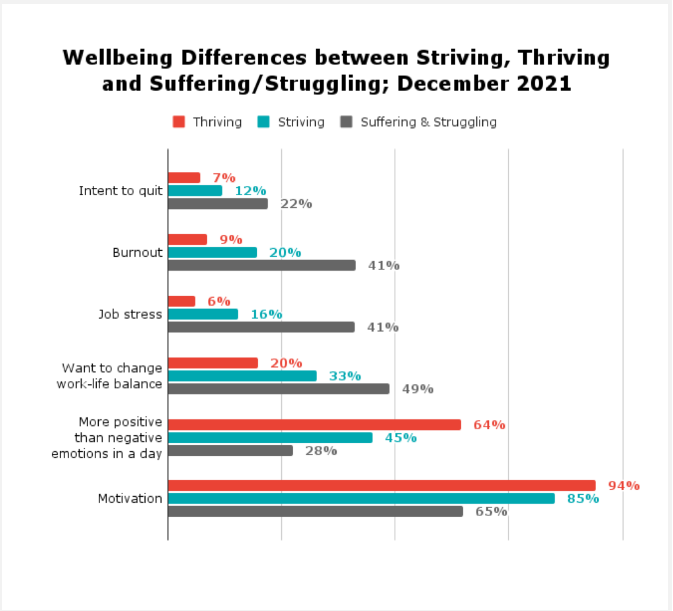Report: Employee well-being sees modest improvement
A recent survey shows that while employee wellness is on the rise, the perception of employer support has dropped. Here’s what wellness pros should know.

For the first time in nearly two years, the most recent meQuilibrium Self-Check indicates a reversal in the downward trend of employee well-being, with modest improvements across several employee well-being indicators. Conducted twice a year, the most recent survey took place in December 2021 and received 6,369 responses from its members, who are employed adults who work for U.S.-based or multinational organizations.
Compared to December 2020 results, the survey reports lowered rates of burnout, job stress and intent to quit. However, employee respondents indicate a lowered rate of feeling “strongly supported” by their employer (63% in 2021 vs. 71% in July of 2021 and 78% in December of 2020).
This lowered rate of perceived employer support is especially concerning because the meQuilibrium survey reports that employees who feel “strongly supported” have broadly better well-being outcomes than those who do not. Well-supported employees are:
- More positive.
- Achieving better work-life balance.
- Reporting less burnout.
- Indicating lower job stress.
- More motivated.
- Less likely to quit.

This meQuilibrium Self-Check asked what employer actions respondents find the most supportive. Four things rose to the top: flexible work location, emotional concern from managers, flexible work schedule and clear communications around the pandemic and safety precautions.
The survey does note that current work location drives some of what employees found most supportive. Remote/hybrid employees value a flexible location 258% more than on-site employees and value a flexible schedule 56% more. Meanwhile, good employer communication around the pandemic was valued 56% more by on-site employees.
More than half of respondents are “striving”
The meQuilibrium Self-Check classifies its respondents along a continuum based on stress management scores. In December 2021, 17% of the employee respondents are “thriving,” 53% are “striving” and 29% are “suffering/struggling.” Single, never-married employees are 74% more likely to be in the suffering/struggling group than either striving or thriving groups, and employees ages 18-29 are 2.4 times more likely to be suffering/struggling, too.

There are well-being differences between the three classifications. Most notably around job stress. Only 6% of those thriving and 16% of those striving report job stress compared to 41% of those suffering/struggling. Also, the meQuilibrium study reports that more than 1 in 3 employee respondents in the suffering/struggling group show signs of depression or anxiety.
That’s not to say mental health concerns did not impact either of the other groups. The striving group indicates a 5% risk for anxiety and a 7% risk for depression.
While the survey results are limited to users of meQuilibrium’s Self-Check product, the impact of employer support on employee well-being is clear. And that support certainly appears to have room for improvement when only 17% of this survey’s respondents indicate they are thriving.
What are you doing to help employees thrive, readers? Let us know by emailing kaceyl@ragan.com.
Looking for more on this topic? We suggest: Reframing the workplace wellness debate as part of employer branding.
COMMENT
Ragan.com Daily Headlines
RECOMMENDED READING
How I got here: Joel Johnson on the key to excellence in storytelling
How to beat boredom and recapture the joy of writing
Tags: burnout, employer support, flexibility, internal communications, mental health, meQuilibrium, well-being






